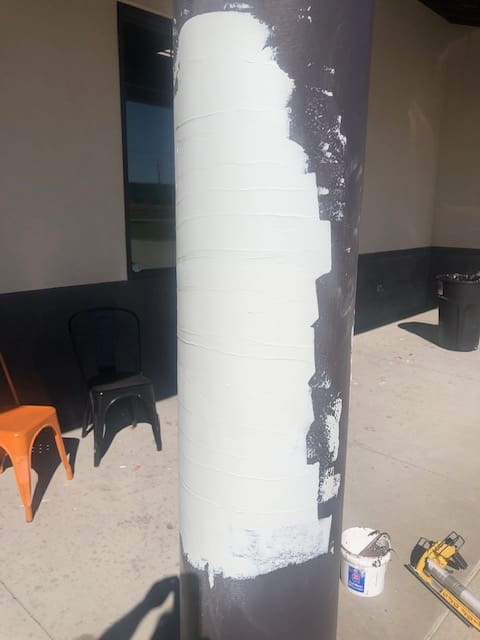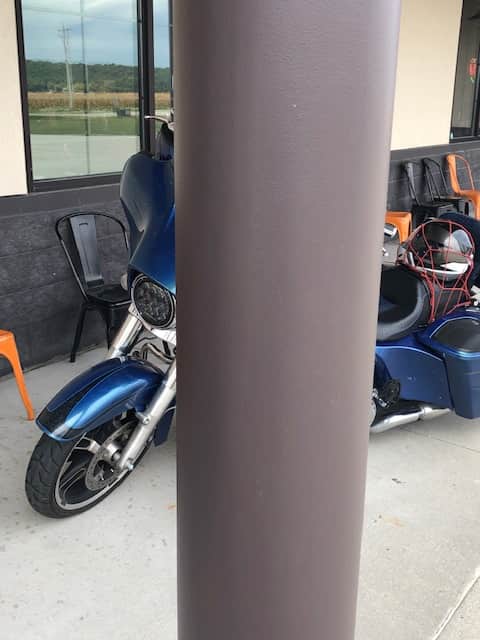We recently did two commercial painting projects and both involved repair and painting columns. One job was in Council Bluffs Iowa and the other was in Bellevue Nebraska. The first one in Council Bluffs had columns that were not too bad. Peeling paint and a bit gouged up. These we sanded down and we used a couple coats of glazing putty on them.

The putty is a two component product. You have to move fairly fast. On the upside it sands out easily. We then prime it out and paint it.

The second project had columns in much worse shape. For these we used a commercial filler product because of the depth of the repair. Then we finished it off with the glazing putty.

When doing this type of repair work and painting columns it is very important to sand thoroughly and correctly. The curved nature will highlight poor sanding. We always do a couple coats of a quality primer as well.
Repairs of this type are time consuming but when done right the results are great. If you’re planning to give your exterior columns a fresh coat of paint, there are a few steps you can take to ensure that the job is done right.
Consider the weather: Make sure to choose a dry, sunny day to paint the columns, as wet or humid conditions can affect the drying time and quality of the paint job.
Use a ladder safely: If you need to use a ladder to reach the top of the columns, make sure to set it up on a stable, level surface and use caution when climbing. It’s also a good idea to have someone hold the ladder steady or use a ladder stabilizer.
Prepare the columns: Begin by removing any loose or peeling paint with a scraper or sandpaper. If the columns have any cracks or imperfections, fill them in with a commercial filler or bondo and sand the surface smooth. Use a cloth or brush to remove any dust or debris from the columns.
Choose the right paint: Select a high-quality exterior paint that is specifically designed for wood surfaces. Opt for a paint with a satin or semi-gloss finish, as it will be more durable and easier to clean than a flat finish.
Protect nearby surfaces: Cover any nearby plants, bushes, or other sensitive areas with drop cloths to protect them from overspray. If you’re painting columns that are attached to a house or commercial structure, make sure to also cover windows, doors, and other surfaces to avoid getting paint on them.
Prime the columns: Applying a coat of primer to the columns before painting can help the paint adhere better and last longer. Make sure to follow the manufacturer’s instructions and allow the primer to dry completely before proceeding.
Paint the columns: Use a brush or roller to apply the paint to the columns, starting at the top and working your way down. Make sure to paint the corners and edges thoroughly, and overlap your brushstrokes to ensure even coverage. Allow the first coat of paint to dry completely before applying a second coat.
Take breaks: Painting can be physically demanding, so be sure to take breaks as needed and stay hydrated. If you start to feel tired or dizzy, stop immediately and rest before continuing.
Use protective gear: Wear protective gear such as goggles, gloves, and a mask to avoid inhaling paint fumes and protect your skin and eyes from accidental splashes.
Clean up thoroughly: When you’re finished painting, clean your brushes and rollers thoroughly and store them properly. Dispose of any leftover paint according to local regulations, and properly dispose of any rags or drop cloths that may have been contaminated with paint.
Finish up: Once the second coat of paint has dried, remove the drop cloths and any masking tape you may have used. Check the columns for any missed spots or drips, and touch them up as needed.
By following these additional tips, you can ensure that your exterior column painting project goes smoothly and safely.


